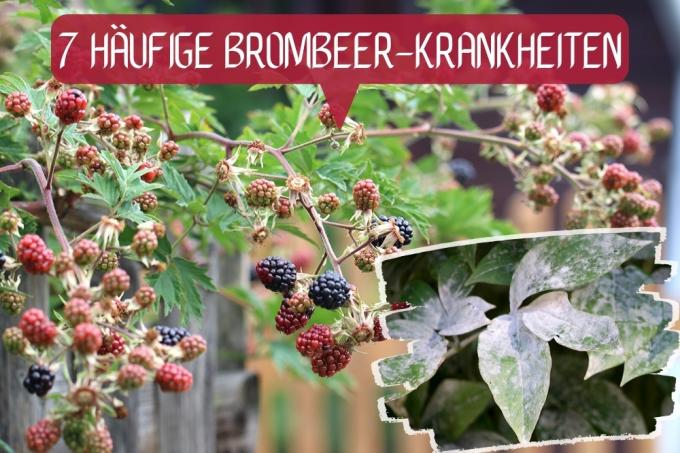
table of contents
- Blackberry rust
- Colletotrichum fruit rot
- Powdery mildew
- Wrong mildew
- Gray mold
- Tendril disease
- Rubus dive
From August the blackberry bushes full of black, juicy fruits hang along the roadsides and in numerous gardens. Sometimes, however, the hoped-for harvest is endangered, because even the robust blackberries are not immune to disease. Thornless varieties are particularly affected, but old varieties are also occasionally affected. In this article, we will explain which 7 infections are particularly common and how you can recognize and treat them.
Blackberry rust
Blackberry rust is a problem especially with the new thornless varieties. The fungus Phragmidium violaceum causes this quite common disease, which usually appears from the end of June / beginning of July. But even if you don't recognize any symptoms yet, your blackberries may already be infected: The fungus overwinters in the fallen leaves and on the leaves that have remained on the tendrils. From here he infects the new leaves that sprout in spring.
Damage image
You can recognize blackberry rust by these characteristic symptoms:
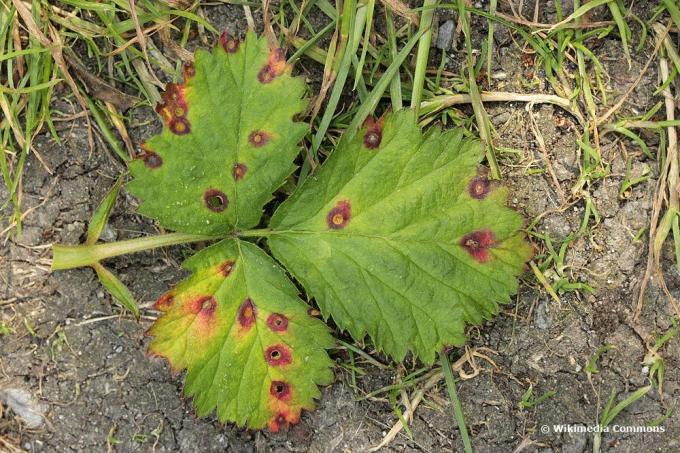
- purple to reddish spots on the upper side of the leaf
- later formation of orange-red spore beds on the underside of the leaves
- turn brown to black over time
Without treatment, the fungus does not go away, but infects the blackberries anew every year.
Control and Prevention
Blackberry rust is one of the more harmless diseases, because the harvest is only in danger if it is heavily infested. Therefore, do not resort to chemical pesticides straight away, but try these methods first:
- remove or remove infected leaves from the bush pick up from the ground
- under no circumstances throw it on the compost
- Spores survive there and cause renewed infection in the next year
- Disposal of infected leaves with household waste or by incineration
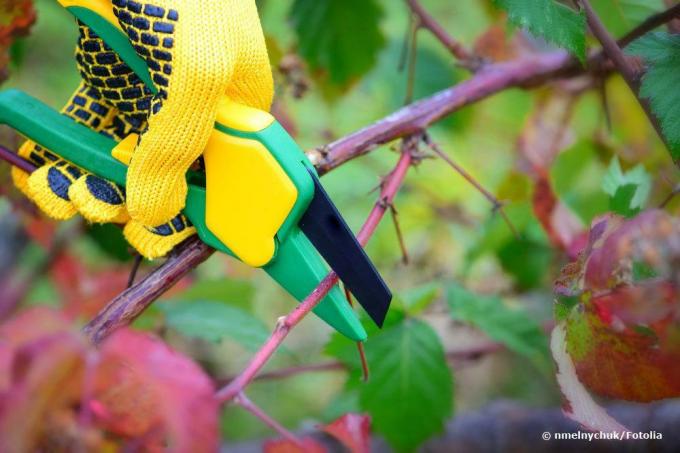
The disease can be prevented quite well by a regular clearing cut in summer. In addition, you should only use nitrogenous fertilizers very sparingly, as this makes the blackberries more sensitive to a fungal infection.
Tip: Those who want to avoid blackberry rust can also plant resistant varieties such as the thornless 'Arapaho'. On the other hand, the 'Thornless Evergreen' variety is particularly susceptible.
Colletotrichum fruit rot
More problematic for a rich blackberry harvest, on the other hand, is the Colletotrichum fruit rot, which is caused by fungi of the Glomerella cingulata species. This wilt disease is also known as anthracnose and often occurs on currants. Therefore, an infection of the blackberry plants from neighboring currant bushes is likely.
The Colletotrichum fruit rot occurs in wet and warm weather, so it is not uncommon in both wet and warm summers. The pathogen spreads very quickly and can lead to crop failures of up to 30 percent.
Damage image
Colletotrichum fruit rot is one of the diseases in blackberries with a characteristic appearance and can therefore be diagnosed even for laypeople. Typical symptoms are:
- first signs of fruit ripening
- initially only affects individual berries
- do not first turn red and then black, but rather milky
- small pustules on the surface containing pink spores
- Infested berries dry up, mummify
- stick to the bush, do not fall off
If the infestation is severe, the entire plant suffers and shows, for example, stunted growth and delayed ripening of remaining blackberries.
Control and Prevention
The disease mainly occurs in late-bearing varieties, so planting earlier blackberries can prevent an outbreak of infection. You should also avoid a new outbreak of the disease in the following year by consistently removing fruit mummies and pruning the infected plant vigorously in autumn. The use of chemical pesticides is not necessary.
Powdery mildew
Powdery mildew is also one of the fungal diseases. It is caused by fungi from the Erysiphaceae group and occurs on numerous garden plants, not just blackberries. The disease is nicknamed "fair weather mushroom" because an infection only occurs in warm and dry weather. Temperatures above 24 ° C are ideal for spore formation and rapid spreading, which is why powdery mildew can mainly be seen in the warm summer months.
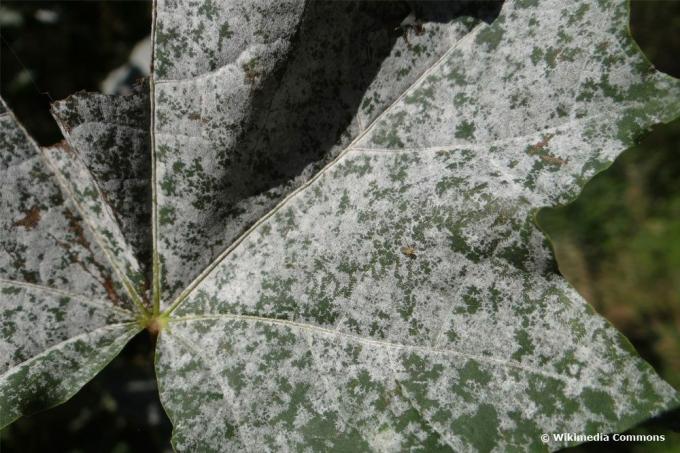
Damage image
Initially, the fungus only affects the leaves and appears as a whitish, floury-like and easily wipeable coating on the leaf surfaces. In addition, shoots and flower buds can also be affected. In the early stages, powdery mildew can still be treated very well with home remedies. If you intervene too late, however, the infection affects the entire plant and can even infect neighboring plants. Other symptoms of a fungal attack are also curled and stunted leaves that eventually fall off.
Control and Prevention
Fungal diseases such as powdery mildew must be treated as the spores hibernate on the plant and thus cause a new infection every year. In the long run, this weakens the plants and ensures that growth slows down and fewer and fewer flowers and fruits are formed. Therefore proceed as described:
- Cut back infected leaves and other parts of the plant
- Do not throw clippings on the compost
- Disposal via household waste, recycling center or incineration
- Treat the blackberry plant with a spray cure
- Use a milk-water mixture (1 part whole milk that is as fresh as possible, 9 parts low-lime water)
Alternatively, you can also spray with baking soda: Mix a packet of baking soda (no baking powder!) With one liter of water and 20 milliliters of cooking oil. A splash of detergent will cause the water and oil to emulsify. You can also carry out the spray treatment for endangered plants (such as those that were sick in the previous year) as a preventive measure. To do this, spray them every two weeks from the spring emergence.
Tip: The white fungus coating on the leaves is not poisonous, but can cause allergic reactions in certain people. Patients who are allergic to penicillin or other fungal allergies are particularly at risk. If you are affected, protect yourself by using a breathing mask and gloves.
Wrong mildew

Downy mildew is also one of the diseases that primarily affect the leaves. It is caused by fungi from the group of Peronosporaceae, which are so-called egg fungi. These occur primarily in cooler, damp weather, as they are transmitted by rain and penetrate the wet leaves of the blackberries. Here the fungi develop further spores that easily infect neighboring plants. Downy mildew occurs mainly in spring and autumn.
Damage image
You can easily recognize downy mildew by its characteristic damage pattern:
- initially a white-gray, wipeable coating on the underside of the leaves
- looks floury, but is difficult to wipe off
- yellow-brown spots on the upper side of the leaves
- Stunted growth / stunted growth with severe infestation
- delayed flower and fruit development
- delayed fruit ripening
Because of its increased occurrence in bad weather, downy mildew is also known as "bad weather fungus".
Control and Prevention
Like so many fungal diseases, this pathogen hibernates on the infected plant and infects it again the next spring. To prevent this and its further spread, you should immediately take countermeasures:
- Cut off infected leaves and other parts of the plant
- do not throw it on the compost, but dispose of it with household waste
- Sprinkle blackberries with horsetail stock
- alternatively use garlic stock
- Repeat application at regular intervals
- Provide for dryness if possible
Tip: Blackberries and other garden plants are less at risk if you plant them in an airy location. In addition, it is important to regularly cut the thinning so that the leaves are not too dense and dry out quickly after a downpour.
Gray mold
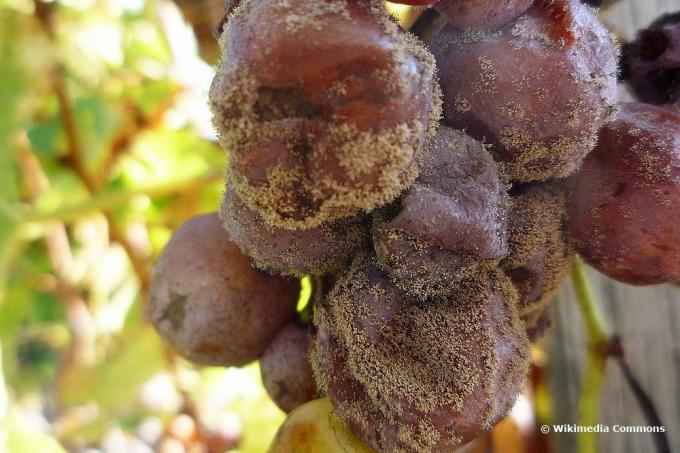
The gray mold caused by the fungus Botrytis cinerea is one of the most common blackberry diseases. This mainly affects the berries, which is why one speaks of fruit rot. Gray mold fruit rot occurs when the air humidity is high (e.g. as a result of a rainy summer) or because the blackberries are too dense and not airy enough.
Damage image
The disease manifests itself as a gray, dusty coating on the fruits. They can no longer be eaten or processed. Tendrils and leaves are only affected if the infestation is more severe.
Control and Prevention
Botrytis spores are present in every garden, so infection is likely if the conditions are right. You should therefore prepare for an outbreak of disease through regular clearing and a suitable location (sunny and airy). Infested parts of the plant must be cut off and disposed of immediately, but not via the compost. Cut generously.
Tendril disease
Tendril disease is one of the diseases that are typical of blackberries. This occurs mainly in rainy weather.
Damage image
Tendril disease manifests itself through these symptoms:
- purple spots on the tendrils
- often provided with a reddish border
- and brownish in the center
- heavy infestation leads to weakening, stunted growth and death of the plant
This year's tendrils - that is, young ones - that are contaminated with the pathogen Rhabdospora ramealis between April and June are mostly affected by an infection. The disease is particularly common in some regions.
Control and Prevention
In the event of an infection, cut away the infected tendrils generously and dispose of the clippings. Here, too, it is important not to throw the plant parts contaminated with spores on the compost, as a renewed infection is then likely. For a new planting, choose resistant or insensitive varieties such as 'Thornless Evergreen'.
Rubus dive
The Rubusstauche does not belong to the fungal, but to the bacterial diseases. It is caused by parasitic bacteria called phytoplasms. These are mainly located in the plant roots. The pathogens are transmitted via insects, mainly cicadas. In addition to blackberries are also Raspberries affected by this dangerous disease.
Damage image
Typical of this disease are not only the noticeable deformations of the flowers and fruits, but also the formation of numerous small, thin rods from the tendril buds. For this reason, the rubus diver is also known as branching disease or witch's broom.
Control and Prevention
Control is not possible; instead, infected plants must be completely cleared. Above all, remove the roots as this is where the pathogen is mainly found. Do not plant any more Rubus species at this point. In addition to the various types of blackberry and raspberry, these also include cloudberries and tayberries.



